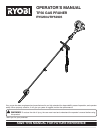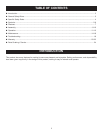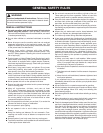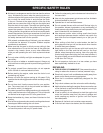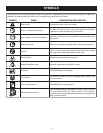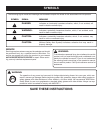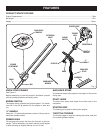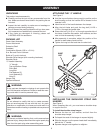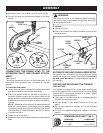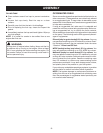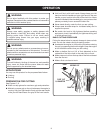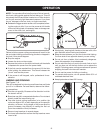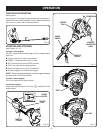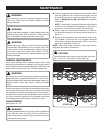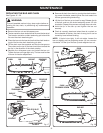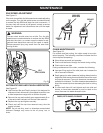
3
WARNING!
Read and understand all instructions. Failure to follow
all instructions listed below, may result in electric shock,
fire and/or serious personal injury.
READ ALL INSTRUCTIONS
For safe operation, read and understand all instructions
before using this product. Follow all safety instructions.
Failure to follow all safety instructions listed below, can result
in serious personal injury.
Do not allow children or untrained individuals to use this
unit.
Never let anyone use the machine who has not received
adequate instructions in the machine’s proper use. This
applies to rentals as well as privately owned units and also
to the power head it is attached to.
Always wear safety glasses with side shields.
Everyday glasses have only impact resistant lenses. They
are NOT safety glasses. Following this rule will reduce the
risk of eye injury.
Product users on United States Forest Service land, and in
some states, must comply with fire prevention regulations.
This product is equipped with a spark arrestor; however,
other user requirements may apply. Check with your federal,
state, or local authorities.
Wear heavy, long pants, boots, and gloves. Do not wear
loose fitting clothing, short pants, or go barefoot. Do not
wear jewelry of any kind. Wear hearing protection.
Heavy protective clothing may increase operator fatigue,
which could lead to heat stroke. During weather that is hot
and humid, heavy work should be scheduled for early morning
or late afternoon hours when temperatures are cooler.
Never operate this unit on the operator’s left side.
Secure long hair above shoulder level to prevent entangle-
ment in moving parts.
Keep all bystanders, children, and pets at least
50 ft. away. Bystanders should be encouraged to wear
eye protection. If you are approached, stop the engine and
cutting attachment. In the case of bladed units, there is the
added risk of injury to bystanders from being struck with
the moving blade in the event of a blade thrust or other
unexpected reaction of the saw.
Do not operate this unit when you are tired, ill, or under the
influence of alcohol, drugs, or medication.
Do not operate in poor lighting.
Do not operate in rain or use in damp or wet environ-
ments.
Keep firm footing and balance. Do not overreach. Over-
reaching can result in loss of balance or exposure to hot
surfaces.
Keep all parts of your body away from any moving part.
To avoid hot surfaces, never operate the unit with the bottom
of the engine above waist level.
GENERAL SAFETY RULES
Do not touch area around the muffler or cylinder of the unit.
These parts get hot from operation. Failure to heed this
warning could result in possible serious personal injury.
Carry the chain saw with the engine stopped, the guide bar
and saw chain to the rear, scabbard on the guide bar and
saw chain, and the muffler away from your body.
Always stop the engine and remove the spark plug wire be-
fore making any adjustments or repairs except for carburetor
adjustments.
Inspect the unit before each use for loose fasteners, fuel
leaks, etc. Replace any damaged parts before use.
The chain may rotate during carburetor adjustments.
It has been reported that vibrations from hand-held tools
may contribute to a condition called Raynaud’s Syndrome
in certain individuals. Symptoms may include tingling, numb-
ness and blanching of the fingers, usually apparent upon
exposure to cold. Hereditary factors, exposure to cold and
dampness, diet, smoking and work practices are all thought
to contribute to the development of these symptoms. It is
presently unknown what, if any, vibrations or extent of ex-
posure may contribute to the condition. There are measures
that can be taken by the operator to possibly reduce the
effects of vibration:
a) Keep your body warm in cold weather. When operat
-
ing the unit wear gloves to keep the hands and wrists
warm. It is reported that cold weather is a major factor
contributing to Raynaud’s Syndrome.
b) After each period of operation, exercise to increase blood
circulation.
c) Take frequent work breaks. Limit the amount of exposure
per day.
d) Keep the tool well maintained, fasteners tightened and
worn parts replaced.
If you experience any of the symptoms of this condition,
immediately discontinue use and see your physician about
these symptoms.
Mix and store fuel in a container approved for gasoline.
Mix fuel outdoors where there are no sparks or flames. Wipe
up any fuel spillage. Move 30 ft. away from refueling site
before starting engine.
Stop the engine and allow to cool before refueling or storing
the unit.
Allow the engine to cool, empty the fuel tank, and secure
the unit from moving before transporting in a vehicle.
Check for damaged parts. Before further use of the tool, any
part that is damaged should be carefully checked to deter-
mine that it will operate properly and perform its intended
function. Check for alignment of moving parts, binding of
moving parts, breakage of parts, mounting, and any other
conditions that may affect its operation. A guard or other part
that is damaged should be properly repaired or replaced by
an authorized service dealer. Be sure the chain stops moving
when the throttle trigger is released. Following this rule will
reduce the risk of shock, fire, or serious injury.



